The coast will be even clearer in Fall if you can travel during the week, when families with kids are otherwise occupied (though you may encounter those kids on field trips). But even weekends are lighter in terms of fellow travelers, at least once you get well north of Marin. You may even find it possible to pitch a tent at state park campgrounds without a reservation. Kind of like California in the 1950s.
Choosing how you’ll get where you’re going is every bit as important as your destination, or so it seems to me. Always be willing to sacrifice efficiency for serendipity and you’ll be a happier camper.
If you’re heading to Sonoma County from the Sacramento Valley, for example, you could easily take Hwy. 20 straight past Clear Lake to connect with 101 and then head south, what I call the engineer’s option (go straight here, go straight there). But a much more scenic route delivers you directly into Napa Valley wine country. Take the cutoff south to Clearlake (the town), a route that continues through Middletown and past easily missed Robert Louis Stevenson State Park—great for a quiet hike—before corkscrewing down into Calistoga. That wild ride down the hill thrilled me every time when I lived in Sonoma County, a sure sign I was almost home. From the outskirts of Calistoga it was just a half-hour more, past California’s modest version of Old Faithful Geyser on Tubbs Lane, past the Petrified Forest too, then west on River Road past Four Corners and Korbel and on into to Guerneville—pronounced GURN-vil, not GUR-nee-vil, which is how tourists say it.
Part 1: Point Reyes and Vicinity
Points Reyes National Seashore. Bird-watching. Whale watching and elephant seals. Teeming tidepools and open ocean vistas. Cowgirl Creamery. Need anything more?
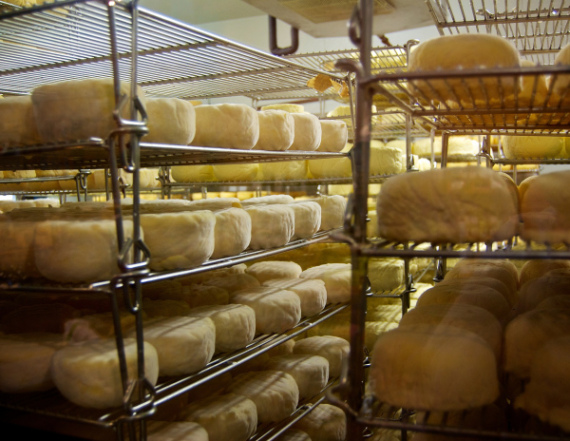
Cheese at Cowgirl Creamery. Photo by Michael LoRusso, Creative Commons 2014
The inland reaches of Marin Country are well-populated and a tad tony, but miracle of miracles, the west is still wild. If you’ve got the time, spend some here. Point Reyes National Seashore is the perfect place to start exploring, with some 65,000 acres of fog-shrouded lagoons, lowland marshes, sandy beaches, coastal dunes, and ridgetop forests. Point Reyes also features windy headlands and steep, unstable, colorful cliffs, populations of tule elk and grazing cattle, nesting snowy plovers, and a wonderful lighthouse all too popular for winter whale-watching. A dramatically dislocated triangular wedge of land with its apex jutting out into the Pacific Ocean, Point Reyes is also land in motion: this is earthquake country. Separated from mainland Marin County by slitlike Tomales Bay, the Point Reyes Peninsula is also sliced off at about the same spot by the San Andreas Fault. When that fault shook loose in 1906–instantly thrusting the peninsula 16 feet farther north–the city of San Francisco came tumbling down.
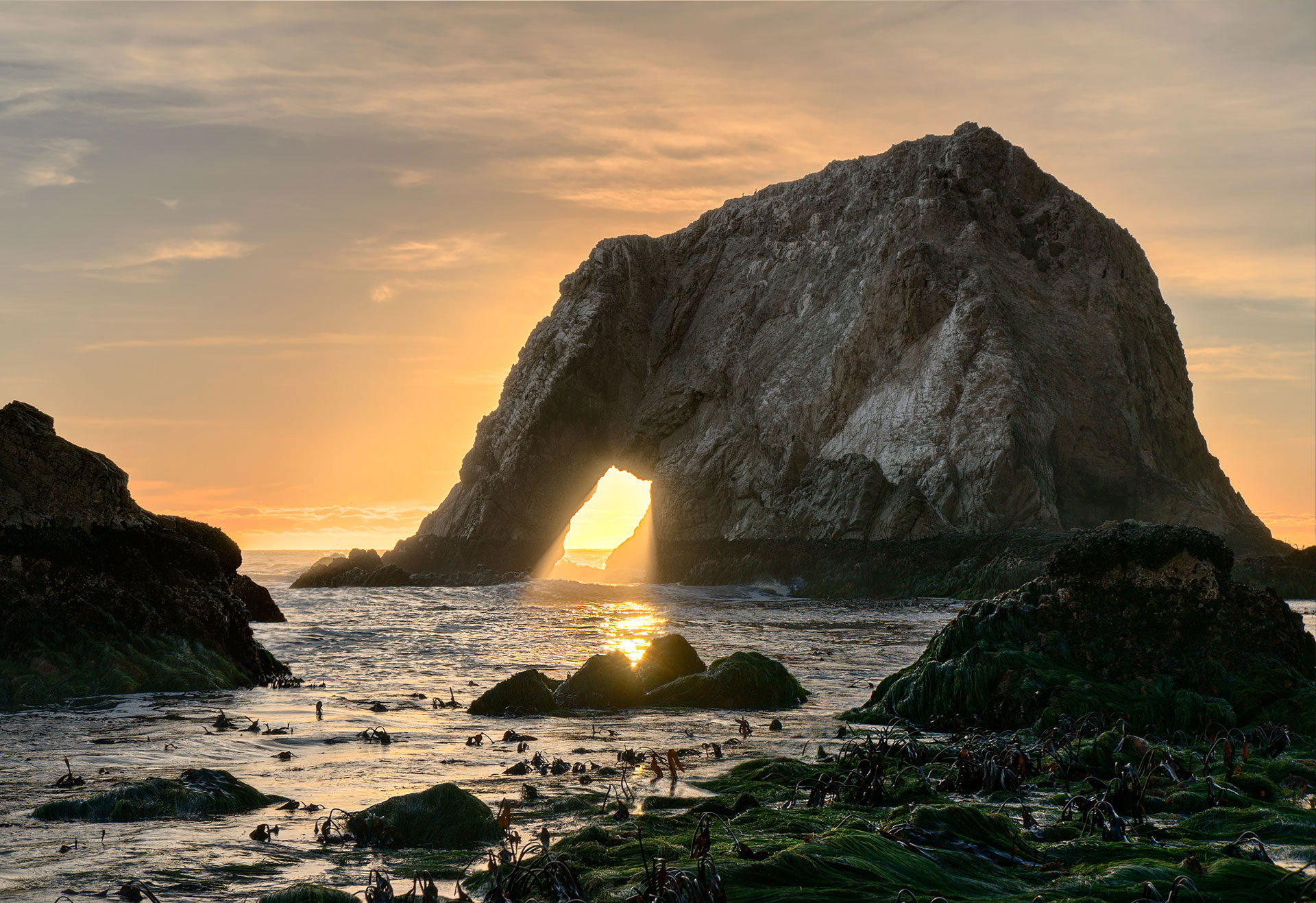
Elephant Rock Sunset, Point Reyes National Seashore. Photo by Steven Bratman, Creative Commons 2014
Get oriented at the park’s barnlike Bear Valley Visitor Center, just off Bear Valley Rd. (off Hwy. 1 near Olema), which, in addition to natural history and fine arts exhibits, includes a seismograph for monitoring the earth’s movements. There are also three solar-powered electric vehicle charging stations, as of this month. Near the picnic tables at the visitor center is the short Earthquake Trail loop (wheelchair accessible), which demonstrates the San Andreas seismic drama, from sag ponds and shifts in natural boundary lines to the old Shafter Ranch barn, a corner of which slid off its foundations during the 1906 San Francisco earthquake. Also near the Bear Valley Visitor Center are the short, self-guided Woodpecker Nature Trail; the Morgan Horse Ranch, where the Park Service breeds and trains its mounts; and Kule Loklo, an architectural re-creation of a Coast Miwok community. Limantour Estero near Drakes Estero and Drakes Beach is great for bird-watching; McClures Beach is best for tidepooling; and both North Beach and South Beach north of Point Reyes proper offer good beachcombing but treacherous swimming. Protected Drakes Beach and Limantour Beach along the crescent of Drakes Bay are safe for swimming.
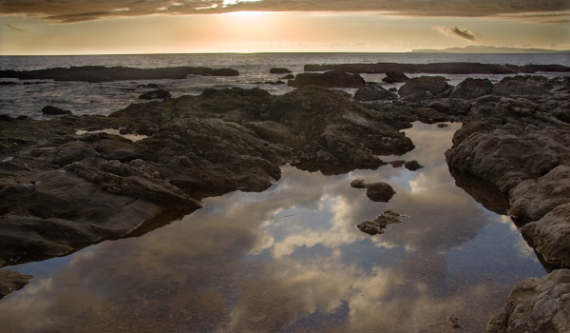
Untitled. Photo by John Curley, Creative Commons 2014
Other western Marin highlights include portions of Golden Gate National Recreation Area (GGNRA), including the endlessly hikable Marin Headlands; the still-operating 1877 Point Bonita Lighthouse, one of the first on the west coast, actually just a massive Fresnel lens approached via hand-dug tunnels and a swaying foot-bridge; and remnants of military installations, including the tourable Nike Missile Site. “The Rock,” infamous Alcatraz, onetime military outpost, then island prison and federal hellhole for hard-core criminals, is also part of GGNRA. Schedules vary but tours are available year-round.
You can also take the ferry to Angel Island State Park, where you can explore the beautifully restored United States Immigration Station museum. Make reservations for the shuttle to and from, open-air tram rides, Segway island tours, and the ferry ride.
Don’t overlook the national monument and other state parks effectively surrounded by the GGNRA, all worth some time. Muir Woods National Monument within the boundaries of Mt. Tamalpais State Park is peaceful and serene but quite a popular place—not necessarily the best destination for getting away from them all. Avoid the crowds from all those tour buses by getting away from the visitor center and the trails near the parking lot. Mt. Tamalpais State Park stretches downslope to the sea, taking in views of Marin County, San Francisco Bay, and the Pacific Ocean, and otherwise has it all: redwoods and ferns, hillsides thick with wildflowers, 200 miles of hiking trails with spectacular views, beaches and headlands, also camping and picnicking.
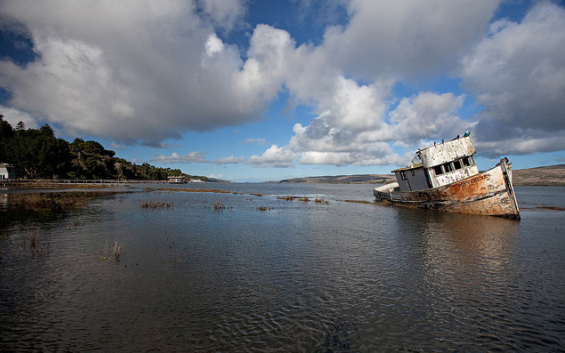
This battered boat is an icon in Inverness, along Tomales Bay. Point Reyes boat in Inverness by Richard James, Creative Commons 2014
Among the half-moon beaches and secret coves along the steep cliffs and shores of Tomales Bay are those protected within fragments of Tomales Bay State Park. One section is just north of Inverness, via Pierce Point Rd. off Sir Francis Drake Blvd., and others are scattered along Hwy. 1 north of Point Reyes Station on the east side of the bay. Heart’s Desire Beach is perfect for picnicking and is usually empty on weekdays. East of Point Reyes National Seashore and hemmed in by the GGNRA is Samuel P. Taylor State Park, 2,600 acres of redwoods, mixed forests, and upcountry chaparral reached via Sir Francis Drake Boulevard. The park offers an extensive hiking and horseback trail system, a paved bicycle path running east-west, family campsites, group camps, and no-frills camping. Bolinas Lagoon and Audubon Canyon Ranch are also well worth a visit, seasonally.
Farallon Islands, “California’s Galapagos”
If you’re here in Fall for the natural history, consider a trip out to the Farallon Islands wildlife refuge and marine sanctuary with the nonprofit Oceanic Society, offering nature-watching outings on weekends from May through November. Protected as the Farallon National Wildlife Refuge and the largest seabird rookery south of Alaska, these islands are one of the five most ecologically productive marine environments on earth, now part of an international UNESCO Biosphere Reserve. Sometimes called “California’s Galapagos,” these 948 square nautical miles of ocean from Bodega Head to Rocky Point are included in the Gulf of the Farallones National Marine Sanctuary. Rugged granite islands rising up 27 miles west of San Francisco, the Farallons are actually the above-sea-level presence of the Farallones Escarpment, which parallels the coast from the tip of Point Reyes to south of the Golden Gate. The natural but rare phenomenon of upwelling around the islands, with warm offshore winds drawing cold, nutrient-rich ocean water to the surface in spring, creates the phenomenal algae and plankton populations that support the feeding frenzies and breeding successes of animals farther up the food chain.
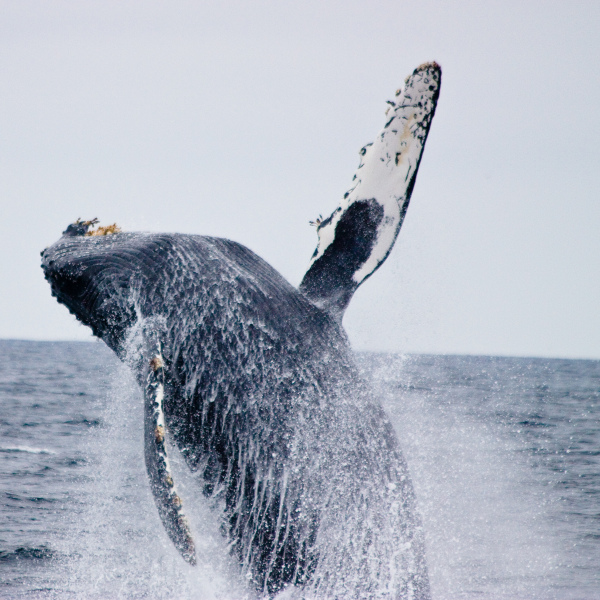
On an Oceanic Society tour of the Farallon Islands. Photo by Ken-ichi Ueda, Creative Commons 2014
But during recent centuries, life was almost undone at the Farallons. In the 1800s, “eggers” exploited the rookeries here to provide miners and San Franciscans with fresh eggs at breakfast. The islands have also survived assaults from sealers, whalers, gill netters, bombers, ocean oil slicks, and radioactive waste dumping.
In the summer, more than 250,000 breeding birds—from tufted puffins and petrels to auklets and murres—consider the Farallones home. Seals (including the once-almost-extinct northern elephant seal) and sea lions also breed here, and gray and humpback whales as well as northern fur seals are often spotted in the area.
For more information about the Farallon Islands and the surrounding marine sanctuary, contact the Farallones Marine Sanctuary Association, headquartered at the Presidio in San Francisco.
Going on the Cheap
You’ll find a friendly assortments of B&Bs, historic hostelries, and family-owned motels in the area. For some great choices contact the Western Marin Chamber of Commerce in Point Reyes Station.
For aficionados of traveling on the cheap, western Marin offers a surprising wealth of choice—including two fine hostels and two historic if fairly primitive options. There are also two very inviting, publicly owned conference centers, if your company or organization is seeking someplace inspiring for that next retreat.
Hostelling International’s historic Marin Headlands Hostel at circa-1907 Fort Barry, 415-331-2777, offers 103 beds, early-20th-century hospital buildings, and a park-like setting. Basic dorm-style accommodations predominate here but family rooms in the annex are available by advance reservation. (No private bathrooms; shared hallway baths.) Facilities also include a great kitchen (bring your groceries), dining room, common room with fireplace, even laundry facilities, game room, tennis court, and bike storage. Quite popular in summer and on good-weather weekends, so reservations are advised. For 2014 rates were $28-35 for dorm rooms, $82-132 for a private room sleeping up to three. Towels and linens are provided. Ask about group rates.
Ideal for a seashore stay is HI’s Point Reyes Hostel on Limantour Rd. in Point Reyes Station, 415/663-8811. Pluses here include location, location, location, and all that beach, just a couple miles away. Advance reservations advisable. Rates in 2014 for dorm beds: $26-29 per night for adults, $13-14 for children.
The state’s Steep Ravine Environmental Cabins on Rocky Point in Mount Tamalpais State Park look out to sea from near Stinson Beach. Before the state wrested custody of these marvelous cabins from the powerful Bay Area politicians and other clout-encumbered citizens who held long-term leases, photographer Dorothea Lange wrote about staying here in To a Cabin, co-authored by Margaretta K. Mitchell. Even the walk down to the bottom of Steep Ravine Canyon is inspiring, Lange noted, with “room for only those in need of sea and sky and infinity.” These 10 small, rustic redwood cabins offer just the basics: platform beds (bring your own sleeping bag and pad), woodstoves, separate restrooms with pit toilets, and an almost-private beach below in a spectacularly romantic setting. Rates are $100 per night (each sleeps five). One cabin is wheelchair accessible; none have electricity, but they do have outside running water. Bring your own provisions. To reserve a cabin—plan well in advance—try ReserveAmerica online or call 800-444- 7275. Cabins and environmental sites at Mt. Tamalpais may be booked from 10 days to seven months prior to the arrival date. Be determined!
Also notable and inexpensive in the area is the historic, rustic West Point Inn, built in 1904 as a traveler’s stop for the Mill Valley/Mt. Tamalpais Railway and now operated by a nonprofit association dedicated to its preservation. One of the five rustic cabins is wheelchair accessible, and there is a single-use restroom in the main lodge featuring a roll-in shower. Lodge rooms are coziest in winter months. Travelers with disabilities can drive in on an access road, but otherwise this is strictly a hike-in or bike-in experience. (Bring your own food. Lodge cooking facilities available.) Rates are $25 to $50 per person per night, with a two-night minimum for cabins. For more information and reservations, contact the West Point Inn, 1000 Panoramic Highway in Mill Valley, 415-388-9955.
As for those conference centers: Along the eastern edge of Tomales Bay the Marconi Conference Center, 18500 Hwy. 1 in Marshall, occupies the 1914 Marconi Hotel once owned by Guglielmo Marconi, inventor of the wireless. This onetime communications center facility—taken over by the U.S. Navy during World War I, later operated by RCA, and in the 1960s home to the much-praised then pilloried Synanon alcohol and drug abuse program—is now a state-owned conference center operated on the model of Asilomar on the Monterey Peninsula.
Fairly new to the Marin Headlands is Nature Bridge, a conference and event center on the beach at Fort Chronkite. Nature Bridge offers dorm-style accommodations (some semi-private rooms available), good food, lots of meeting space, even guided hikes. Day use and overnight rates available.
Next time: the Sonoma Coast.
Kim Weir is the author of seven California guidebooks for Moon Publications, including most of Moon’s early/original editions on California, such as the best-selling Northern California Handbook. She has been a member of the Society of American Travel Writers (SATW) since 1991.
Going Coastal: Point Reyes and the Marin Coast
The coast will be even clearer in Fall if you can travel during the week, when families with kids are otherwise occupied (though you may encounter those kids on field trips). But even weekends are lighter in terms of fellow travelers, at least once you get well north of Marin. You may even find it possible to pitch a tent at state park campgrounds without a reservation. Kind of like California in the 1950s.
Choosing how you’ll get where you’re going is every bit as important as your destination, or so it seems to me. Always be willing to sacrifice efficiency for serendipity and you’ll be a happier camper.
If you’re heading to Sonoma County from the Sacramento Valley, for example, you could easily take Hwy. 20 straight past Clear Lake to connect with 101 and then head south, what I call the engineer’s option (go straight here, go straight there). But a much more scenic route delivers you directly into Napa Valley wine country. Take the cutoff south to Clearlake (the town), a route that continues through Middletown and past easily missed Robert Louis Stevenson State Park—great for a quiet hike—before corkscrewing down into Calistoga. That wild ride down the hill thrilled me every time when I lived in Sonoma County, a sure sign I was almost home. From the outskirts of Calistoga it was just a half-hour more, past California’s modest version of Old Faithful Geyser on Tubbs Lane, past the Petrified Forest too, then west on River Road past Four Corners and Korbel and on into to Guerneville—pronounced GURN-vil, not GUR-nee-vil, which is how tourists say it.
Part 1: Point Reyes and Vicinity
Points Reyes National Seashore. Bird-watching. Whale watching and elephant seals. Teeming tidepools and open ocean vistas. Cowgirl Creamery. Need anything more?
Cheese at Cowgirl Creamery. Photo by Michael LoRusso, Creative Commons 2014
The inland reaches of Marin Country are well-populated and a tad tony, but miracle of miracles, the west is still wild. If you’ve got the time, spend some here. Point Reyes National Seashore is the perfect place to start exploring, with some 65,000 acres of fog-shrouded lagoons, lowland marshes, sandy beaches, coastal dunes, and ridgetop forests. Point Reyes also features windy headlands and steep, unstable, colorful cliffs, populations of tule elk and grazing cattle, nesting snowy plovers, and a wonderful lighthouse all too popular for winter whale-watching. A dramatically dislocated triangular wedge of land with its apex jutting out into the Pacific Ocean, Point Reyes is also land in motion: this is earthquake country. Separated from mainland Marin County by slitlike Tomales Bay, the Point Reyes Peninsula is also sliced off at about the same spot by the San Andreas Fault. When that fault shook loose in 1906–instantly thrusting the peninsula 16 feet farther north–the city of San Francisco came tumbling down.
Elephant Rock Sunset, Point Reyes National Seashore. Photo by Steven Bratman, Creative Commons 2014
Get oriented at the park’s barnlike Bear Valley Visitor Center, just off Bear Valley Rd. (off Hwy. 1 near Olema), which, in addition to natural history and fine arts exhibits, includes a seismograph for monitoring the earth’s movements. There are also three solar-powered electric vehicle charging stations, as of this month. Near the picnic tables at the visitor center is the short Earthquake Trail loop (wheelchair accessible), which demonstrates the San Andreas seismic drama, from sag ponds and shifts in natural boundary lines to the old Shafter Ranch barn, a corner of which slid off its foundations during the 1906 San Francisco earthquake. Also near the Bear Valley Visitor Center are the short, self-guided Woodpecker Nature Trail; the Morgan Horse Ranch, where the Park Service breeds and trains its mounts; and Kule Loklo, an architectural re-creation of a Coast Miwok community. Limantour Estero near Drakes Estero and Drakes Beach is great for bird-watching; McClures Beach is best for tidepooling; and both North Beach and South Beach north of Point Reyes proper offer good beachcombing but treacherous swimming. Protected Drakes Beach and Limantour Beach along the crescent of Drakes Bay are safe for swimming.
Untitled. Photo by John Curley, Creative Commons 2014
Other western Marin highlights include portions of Golden Gate National Recreation Area (GGNRA), including the endlessly hikable Marin Headlands; the still-operating 1877 Point Bonita Lighthouse, one of the first on the west coast, actually just a massive Fresnel lens approached via hand-dug tunnels and a swaying foot-bridge; and remnants of military installations, including the tourable Nike Missile Site. “The Rock,” infamous Alcatraz, onetime military outpost, then island prison and federal hellhole for hard-core criminals, is also part of GGNRA. Schedules vary but tours are available year-round.
You can also take the ferry to Angel Island State Park, where you can explore the beautifully restored United States Immigration Station museum. Make reservations for the shuttle to and from, open-air tram rides, Segway island tours, and the ferry ride.
Don’t overlook the national monument and other state parks effectively surrounded by the GGNRA, all worth some time. Muir Woods National Monument within the boundaries of Mt. Tamalpais State Park is peaceful and serene but quite a popular place—not necessarily the best destination for getting away from them all. Avoid the crowds from all those tour buses by getting away from the visitor center and the trails near the parking lot. Mt. Tamalpais State Park stretches downslope to the sea, taking in views of Marin County, San Francisco Bay, and the Pacific Ocean, and otherwise has it all: redwoods and ferns, hillsides thick with wildflowers, 200 miles of hiking trails with spectacular views, beaches and headlands, also camping and picnicking.
This battered boat is an icon in Inverness, along Tomales Bay. Point Reyes boat in Inverness by Richard James, Creative Commons 2014
Among the half-moon beaches and secret coves along the steep cliffs and shores of Tomales Bay are those protected within fragments of Tomales Bay State Park. One section is just north of Inverness, via Pierce Point Rd. off Sir Francis Drake Blvd., and others are scattered along Hwy. 1 north of Point Reyes Station on the east side of the bay. Heart’s Desire Beach is perfect for picnicking and is usually empty on weekdays. East of Point Reyes National Seashore and hemmed in by the GGNRA is Samuel P. Taylor State Park, 2,600 acres of redwoods, mixed forests, and upcountry chaparral reached via Sir Francis Drake Boulevard. The park offers an extensive hiking and horseback trail system, a paved bicycle path running east-west, family campsites, group camps, and no-frills camping. Bolinas Lagoon and Audubon Canyon Ranch are also well worth a visit, seasonally.
Farallon Islands, “California’s Galapagos”
If you’re here in Fall for the natural history, consider a trip out to the Farallon Islands wildlife refuge and marine sanctuary with the nonprofit Oceanic Society, offering nature-watching outings on weekends from May through November. Protected as the Farallon National Wildlife Refuge and the largest seabird rookery south of Alaska, these islands are one of the five most ecologically productive marine environments on earth, now part of an international UNESCO Biosphere Reserve. Sometimes called “California’s Galapagos,” these 948 square nautical miles of ocean from Bodega Head to Rocky Point are included in the Gulf of the Farallones National Marine Sanctuary. Rugged granite islands rising up 27 miles west of San Francisco, the Farallons are actually the above-sea-level presence of the Farallones Escarpment, which parallels the coast from the tip of Point Reyes to south of the Golden Gate. The natural but rare phenomenon of upwelling around the islands, with warm offshore winds drawing cold, nutrient-rich ocean water to the surface in spring, creates the phenomenal algae and plankton populations that support the feeding frenzies and breeding successes of animals farther up the food chain.
On an Oceanic Society tour of the Farallon Islands. Photo by Ken-ichi Ueda, Creative Commons 2014
But during recent centuries, life was almost undone at the Farallons. In the 1800s, “eggers” exploited the rookeries here to provide miners and San Franciscans with fresh eggs at breakfast. The islands have also survived assaults from sealers, whalers, gill netters, bombers, ocean oil slicks, and radioactive waste dumping.
In the summer, more than 250,000 breeding birds—from tufted puffins and petrels to auklets and murres—consider the Farallones home. Seals (including the once-almost-extinct northern elephant seal) and sea lions also breed here, and gray and humpback whales as well as northern fur seals are often spotted in the area.
For more information about the Farallon Islands and the surrounding marine sanctuary, contact the Farallones Marine Sanctuary Association, headquartered at the Presidio in San Francisco.
Going on the Cheap
You’ll find a friendly assortments of B&Bs, historic hostelries, and family-owned motels in the area. For some great choices contact the Western Marin Chamber of Commerce in Point Reyes Station.
For aficionados of traveling on the cheap, western Marin offers a surprising wealth of choice—including two fine hostels and two historic if fairly primitive options. There are also two very inviting, publicly owned conference centers, if your company or organization is seeking someplace inspiring for that next retreat.
Hostelling International’s historic Marin Headlands Hostel at circa-1907 Fort Barry, 415-331-2777, offers 103 beds, early-20th-century hospital buildings, and a park-like setting. Basic dorm-style accommodations predominate here but family rooms in the annex are available by advance reservation. (No private bathrooms; shared hallway baths.) Facilities also include a great kitchen (bring your groceries), dining room, common room with fireplace, even laundry facilities, game room, tennis court, and bike storage. Quite popular in summer and on good-weather weekends, so reservations are advised. For 2014 rates were $28-35 for dorm rooms, $82-132 for a private room sleeping up to three. Towels and linens are provided. Ask about group rates.
Ideal for a seashore stay is HI’s Point Reyes Hostel on Limantour Rd. in Point Reyes Station, 415/663-8811. Pluses here include location, location, location, and all that beach, just a couple miles away. Advance reservations advisable. Rates in 2014 for dorm beds: $26-29 per night for adults, $13-14 for children.
The state’s Steep Ravine Environmental Cabins on Rocky Point in Mount Tamalpais State Park look out to sea from near Stinson Beach. Before the state wrested custody of these marvelous cabins from the powerful Bay Area politicians and other clout-encumbered citizens who held long-term leases, photographer Dorothea Lange wrote about staying here in To a Cabin, co-authored by Margaretta K. Mitchell. Even the walk down to the bottom of Steep Ravine Canyon is inspiring, Lange noted, with “room for only those in need of sea and sky and infinity.” These 10 small, rustic redwood cabins offer just the basics: platform beds (bring your own sleeping bag and pad), woodstoves, separate restrooms with pit toilets, and an almost-private beach below in a spectacularly romantic setting. Rates are $100 per night (each sleeps five). One cabin is wheelchair accessible; none have electricity, but they do have outside running water. Bring your own provisions. To reserve a cabin—plan well in advance—try ReserveAmerica online or call 800-444- 7275. Cabins and environmental sites at Mt. Tamalpais may be booked from 10 days to seven months prior to the arrival date. Be determined!
Also notable and inexpensive in the area is the historic, rustic West Point Inn, built in 1904 as a traveler’s stop for the Mill Valley/Mt. Tamalpais Railway and now operated by a nonprofit association dedicated to its preservation. One of the five rustic cabins is wheelchair accessible, and there is a single-use restroom in the main lodge featuring a roll-in shower. Lodge rooms are coziest in winter months. Travelers with disabilities can drive in on an access road, but otherwise this is strictly a hike-in or bike-in experience. (Bring your own food. Lodge cooking facilities available.) Rates are $25 to $50 per person per night, with a two-night minimum for cabins. For more information and reservations, contact the West Point Inn, 1000 Panoramic Highway in Mill Valley, 415-388-9955.
As for those conference centers: Along the eastern edge of Tomales Bay the Marconi Conference Center, 18500 Hwy. 1 in Marshall, occupies the 1914 Marconi Hotel once owned by Guglielmo Marconi, inventor of the wireless. This onetime communications center facility—taken over by the U.S. Navy during World War I, later operated by RCA, and in the 1960s home to the much-praised then pilloried Synanon alcohol and drug abuse program—is now a state-owned conference center operated on the model of Asilomar on the Monterey Peninsula.
Fairly new to the Marin Headlands is Nature Bridge, a conference and event center on the beach at Fort Chronkite. Nature Bridge offers dorm-style accommodations (some semi-private rooms available), good food, lots of meeting space, even guided hikes. Day use and overnight rates available.
Next time: the Sonoma Coast.
Kim Weir is the author of seven California guidebooks for Moon Publications, including most of Moon’s early/original editions on California, such as the best-selling Northern California Handbook. She has been a member of the Society of American Travel Writers (SATW) since 1991.